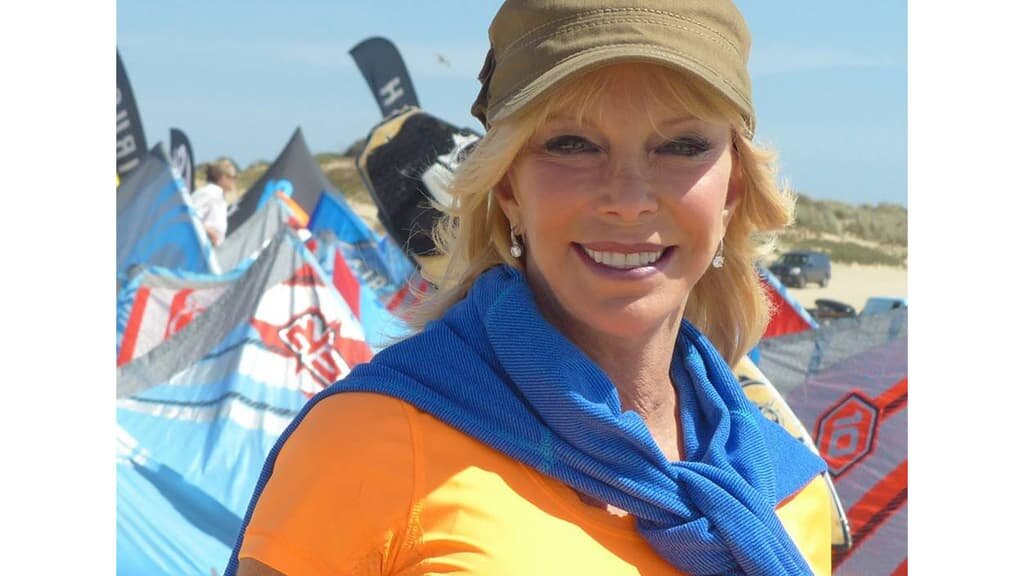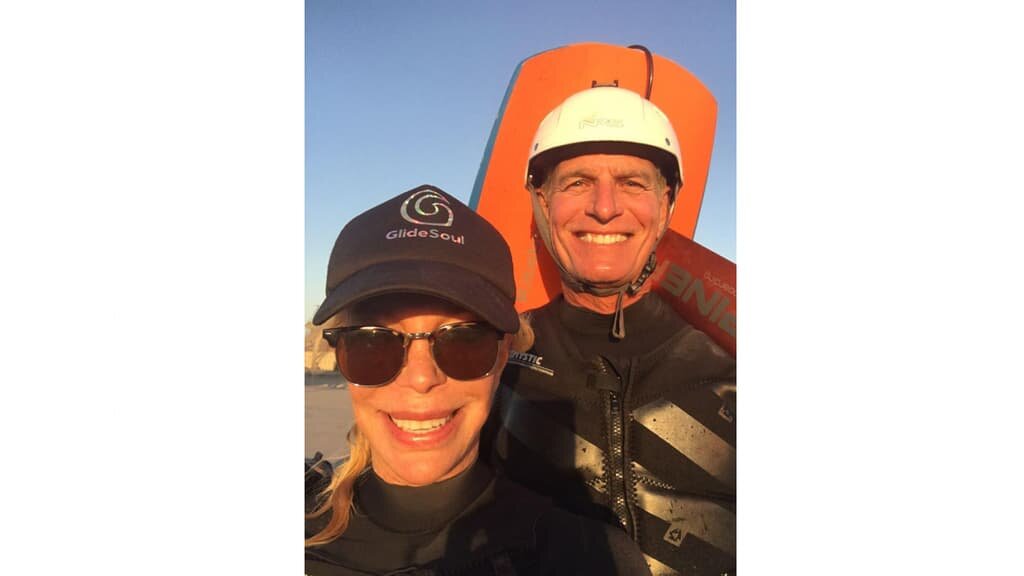Try the new IKO website at https://beta.ikointl.com/

“Can I Ride This, Can I Get over That Next Wave?” an Interview About Learning Kiteboarding at Age 60+
Recently, I sat down for a conversation with a remarkable member of my kiteboarding community at Belmont Shore, California: Joan Krohngold, 65, mother of two adult children, grandmother to an adorable little girl, former collegiate gymnast, gymnastics coach and judge, active ballet dancer, and for the past two years rapidly progressing kiteboarder. On windy days, the petite Joanie and her boyfriend Bob—who has been kiteboarding for a decade—can be found enjoying their retirement on the waves. Learning a sport later in life can present quite a few challenges, and we talked about how she conquered these.
Nina: When and how did you learn about kiteboarding? How did you decide to learn?
Joanie: I had watched my boyfriend kite for a year, and I had decided that the sport would be too rigorous for me. I didn’t see many women out on the water. Also, I’ve been in a few car accidents and have neck issues. But then, I was with Bob on vacation in Mexico, and even before we left, I decided that I would surprise him and take lessons while he was out on the water. And that’s what I did!
I kind of backed into kiteboarding. I thought I can always take a lesson and stop if it seems too rigorous for me. But it seemed OK. I got past my fear of the kite [’s power]. Then I had to deal with another issue: I had never been on ocean person. I didn’t know whether I would be able to manage a kite AND a board AND be out on the ocean AND have these fears [of deep water].
Nina: What were your experiences with the instructors at various IKO Centers? How did they help you progress and overcome these challenges?
Joanie: In Mexico, when Bob went out, I walked over to the IKO Center. I explained my limitations. They said: “No problem, we can work with you!” They were very good. We worked on land, learning kite flying and positions, setting up the kite. Even though I had watched videos, it makes a big difference when you have a good instructor telling you what to do. They can spot how to best help you achieve your goals.
Bob couldn’t believe it when he came back: I had a harness on and was holding a small kite with short lines, walking up and down the beach. He was pretty surprised and excited!
Then we were in Hawaii, and I was trying to work through my fear of the water. My [IKO] instructor had a great method of following me with a soft-top surfboard. We also did some beach work, and I thought: “Well, I am paying for this class, so I should get out into the water now!” The instructor was great. Knowing my limitations and fears, he worked with me, and I was able to body-drag a little bit in both directions. I took three lessons there. I couldn’t take a three-hour lesson, only one-and-a-half-hours, because I would get very tired, physically and emotionally. It was a great experience, and he was very patient and very knowledgeable.
Back in Belmont Shore, I thought I needed to get some more experience on the water, so I continued with an instructor from the local IKO Center. I again expressed my concerns about my neck, about my kite flying abilities. It was a watershed moment: he got me into the water and had me dive the kite without the board, and it pulled me along. It was great—that’s when it really started to happen for me!
I took about 20 hours of lessons [in total], from different IKO Centers. Everybody was wonderful; everybody’s input was of value. It’s always great to learn from many different teachers. You always pick up something new and different. After that, it was practice, practice, practice!
JOANS-KITE-VID from captnkite on Vimeo.
Nina: What motivated you to keep going?
Joanie: Well, I just decided that I can really do this; I can trust myself with the kite. I have learned well enough how to body-drag, how to relocate my board if I become separated, and I could also relaunch the kite if it went in the water… It was my inner determination. And I have taken a lot of lessons, so I should be able to get out there and do it!
Nina: How did your athletic background assist your progression? How does kiteboarding compare to other sports?
Joanie: It helped a lot. All sports are about body management and learning where your body has to be at the right moment in time. [In gymnastics, ballet, and kiteboarding], you’re always making adjustments. You have to know your body. And I always worked out in the gym to maintain body strength.
Kiteboarding has a very steep learning curve. Since I didn’t have any water sports experience—no surfing, no water-skiing—[riding a board] was an unusual feeling. I skied, that helped some, but not much… And kiteboarding requires a lot of time and dedication. But then, once you get it and it all comes together, you think: “Gee, why did it take me so long?”
[Note: Now confidently crisscrossing choppy waters in her second season, Joanie was up and riding much quicker than I did in my 30s!]
Nina: What do you enjoy most about kiteboarding?
Joanie: Now I get in the water at Belmont Shore, and I am ready to do the power-stroke to water-start, and it is fun! Riding out there, challenging myself: “Can you ride this, can you get over that next wave?” Sometimes I follow other kiters and try to ride like they do, trying to improve my riding skills. I enjoy the wind in my face, testing my limits with the kite…
Earlier this season, I had another break-through. I could get out [starboard side], but couldn’t figure out diving the kite port side. At Belmont Shore, we practice so much on the starboard side, so port side was like starting all over again. But then I had that moment: Oh my gosh, I rode out, I was able to transition turn, and go back the other way!
Also, the camaraderie is special. Everyone is so nice and helpful and willing to answer questions. I can still ask questions to my former teachers. Milo [another local IKO instructor, off the clock] was so kind to say on the water: “Follow me!” I followed him and stayed upwind, and that was so amazing! I went back and forth with him at least four times, and I thought: “This is how it is supposed to be like!”
Nina: What are your next goals?
Joanie: I would like to try toe-side riding in flat water. I tried doing some small bunny hops, and I did get off the water a foot [30 cm]. Once I can jump, I’d like to learn back-rolls—I should be able to do that. I also want to learn hydro-foiling eventually.
Nina: Do you have advice for beginners, under or over 60?
Joanie: Once, before I had learned anything about kiting, Bob was standing there with his gear and said: “Come here, hold the kite for a minute.” Suddenly the wind caught the kite, and I landed pretty hard on the sand, biting my lip. Even though I immediately said, never ever will I be involved in this sport, six months later there I was on the beach in Mexico, learning with an instructor… Give everything a second chance, don’t immediately give up it because it seems hard or scary!
If you’re really interested, you stick with it! Give yourself time if you need a little break. If you have aches and pains, take some time off. Keep plugging along and try to get out there. Even if you can’t be out on the beach, you can always watch videos or talk with your kiting friends about your experiences.
It may take you longer than a thirty-year-old, but you have to accept what your body is telling you. I know, people go out there and kite for two hours. I come in after half an hour because I’m tired. You just have to listen to your body saying: “That’s enough for now.” You want to be able to do it later, or the next day!

--
As instructors, we often get asked: “Can I still learn kiteboarding in my 40/50/60s?”. Inevitably I point to Joanie. She is inspiring, not only because of successfully learning the sport in her 60s but also because of her determination to overcome limitations due to old injuries and her fears of the ocean and the kite’s power. She may have seemed the student “least likely to stick with it,” but her own determination, her supportive environment, and her IKO instructors’ careful attention to her specific needs kept her going. Where there’s a will, there’s a way—and it leads over your nearest IKO Center!
Author: Nina Macaraig
.png)

